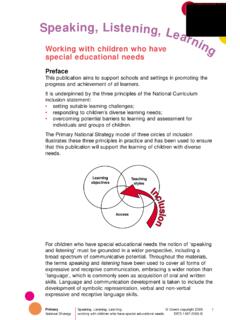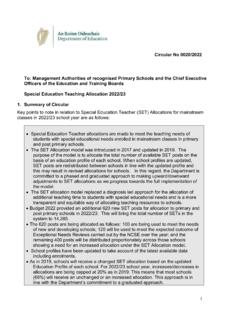Transcription of Review of the Literature on Children with Special Educational …
1 Journal of Education and Practice ISSN 2222-1735 (Paper) ISSN 2222-288X (Online) , , 2016 70 Review of the Literature on Children with Special Educational Needs Mohammed Ali Alkahtani School of Education, King Saud University, PO box 2458, Riyadh 11451 The author extend his appreciation to the College of Education Research Centre, Deanship of Scientific Research, King Saud University for funding this research work. Abstract This study outlines the Literature relevant to the Cross-cultural issues and the politics of SEN and the different perspectives arising from the Literature on this widely debated issue are addressed.
2 In addition, the origin of the term ' Special Educational needs' (SEN), its definitions and the types of Special education needs are presented. Appropriate pedagogy for Children with SEN is also discussed. The results from the Literature Review indicated a number of gaps in the present frameworks. As a result, this has led the scholar to work additional on these frameworks for the aim of this study. Keywords: Cross-cultural issues, the term and the types of SEN, Politics of SEN and Models of disability, and pedagogy for Children with SEN. In this paper, I will Review the Literature related to the present research. This Review is divided into four sections: section one will explain Cross-cultural issues. Section two will touch on the politics of SEN and the different perspectives arising from the Literature on such widely debated issues.
3 Section three will Review the origin of the term ' Special Educational Needs' (SEN), its definitions, and the types of Special education needs as well as discussing the definitions and models. Section four will Review the pedagogy of Children who are SEN. 1. Cross-Cultural Issues In order to properly understand the needs, actions, behaviour and development of the individuals, groups and organisations in a given society, it is essential to first understand the culture of that society. However, it can potentially be challenging to find a universally agreed upon definition of culture, with several definitions existing in the Literature , generally reflecting the particular bias, specialties and backgrounds of the authors. One popular definition was provided by Haralambos, who states that The learned, shared behaviour of members of a society is known as culture (1996:8).
4 In contrast, Hofstede argues that national culture can be best understood as ..collective programming of the mind that distinguishes the members of one group or category of people from another (Hofstede, 2001:9). This former definition holds that individual values are the core of a national culture and it is this definition that will be utilised for further analysis and discussion in this study. In acknowledging the difficulty in changing culture, Hofstede argues that actions and behaviours rarely changing, making individual and societal values an important aspect of culture. These values can be argued as being the basis of concepts of right and wrong, of high quality and low quality, of what's preferred and what is rejected'' (Petrie, 1994:60) There is broad agreement in the Literature that social values are found within individuals, although they are influenced by many internal and external factors, such as family patterns, religion, political or social systems, and training.
5 Therefore, in order to properly understand the effect that society has on the attitudes and behaviours of people, it is necessary to understand society itself and the individuals that make up that society (Petrie, 1994). Petrie also investigates that the ways in which personal values are affected by the mass media, which is an important factor in modern cross-cultural interactions and is therefore likely to be important in the development of values. However, it should also be recognised that the process of changing values and norms in society is normally quite slow, perhaps because the values are passed between generations and are therefore programmed into individuals. State power can also be an important part of this, with state philosophy being able to manipulate the values of people within a society over a long period of time through the introduction of new rules and regulations.
6 An illustration of this is in the changes in power in Eastern Europe in the last few decades. The move from strict to increasingly liberal political systems has resulted in changes to the common norms and values of the people living in these countries. This may have been partially due to the influence of Western European states, in which individuals have traditionally been given more freedom to express their beliefs, culture and traditions. For example, in many Western countries, people are free to open both churches and mosques. The issue of religion is another important factor in the culture of a society, with religion shaping the accepted rules and behaviour of society since the earliest periods of history. Despite these broadly applied factors, individuals are still different, with different perceptions and values regarding important topics, such as the rights of Children with Special needs.
7 Armstrong and Barton have claimed that Within and across societies, individuals and groups have different understanding, values, interpretations and discourses with regard to issues of human rights and disability'' (Armstrong and Barton, 1999:20). Journal of Education and Practice ISSN 2222-1735 (Paper) ISSN 2222-288X (Online) , , 2016 71 In essence, it can therefore be said that national culture affects individual values, which then inform the way that people behave. A number of models exist in order to explain national culture, one of which is Hofstede s (1993) five-dimensional model of national culture. The dimensions that Hofstede uses are: (i) Power distance; (ii) Individualism/collectivism; (iii) Masculinity/femininity; (iv) Uncertainty avoidance; and (v) Long-term/short-term orientation.
8 These dimensions are summarised in more detail below: Power Distance (PD) This dimension describes culture in terms of unequal levels of social status in a society, which means that power is not allocated evenly or fairly between members of the population. Individualism versus Collectivism (IC) This describes the relationship between the individual and the collectively that prevails in a given society (Hofstede, 2001: 209). This dimension therefore describes the degree with which an individual is integrated into a particular society. Masculinity versus Femininity (MF) This dimension refers to how clearly gender roles are defined in a society. For example, the gender roles are classically very clear in masculine societies, where men are expected to be tough and women are expected to be gentle.
9 Uncertainty Avoidance (UA) This refers to how stressed individuals feel when they are not sure about their future. Long-term versus Short-term Orientation (LSO) This is the last of Hofstede s dimensions is that the values are characteristically associated with short-term orientation, such as protection of reputation, fulfilment of social responsibilities and a respect for tradition, are balanced by those values that are deemed to be long-term: perseverance and the ability to make sacrifices for long term gains (Hofstede, 2001). These make it possible to understand what people are focusing on and especially whether they are more concerned with a short-term or long-term approach to life. The ways in which these attitudes manifest in different countries and different cultures can be explained by means of Hofstede s cultural dimensions (Routamaa, Hautala and Mohsin, 2007).
10 For example, the countries of Northern Europe could be seen as individual and feminine, in contrast to Arabic countries which are collective and masculine. In addition, there are often systemic differences in values and attitudes of these cultures (ibid). By using these five dimensions above, it is possible to more fully understand a culture, which can enable deeper understanding of the individual actions and beliefs within that particular society. Hofstede (1980, 1997, and 2003) claims that Western societies tend to be orientated towards individualism, with people being motivated by personal or family needs, and which suggests that historical or cultural issues are less important in these societies than in Eastern countries. According to Dimmock and Walker (1999:98) stated that "eastern and less- developed societies are more collectivist".












